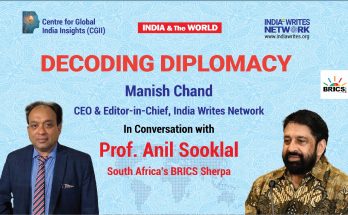 Psychoanalyst and novelist Sudhir Kakar has a genius for digging deep into the depths of the human psyche and diving back with rare gems of insights into the complex grammar of motivations that mark human behaviour and culture. Described by Le Nouvel Observateur as one of 25 major thinkers of the world, Kakar’s oeuvre is varied and includes incisive and pioneering books on the roots of aggression, mysticism, religion and sexuality like Analyst and the Mystic, Culture and Psyche, The Colors of Violence and Intimate Relations.
Psychoanalyst and novelist Sudhir Kakar has a genius for digging deep into the depths of the human psyche and diving back with rare gems of insights into the complex grammar of motivations that mark human behaviour and culture. Described by Le Nouvel Observateur as one of 25 major thinkers of the world, Kakar’s oeuvre is varied and includes incisive and pioneering books on the roots of aggression, mysticism, religion and sexuality like Analyst and the Mystic, Culture and Psyche, The Colors of Violence and Intimate Relations.
Besides erudite and original theorising, Kakar has also penned novels of ideas like The Ascetic of Desire, Ecstasy and Mira and the Mahatma.
 In his new book, The Indians: Portrait of a People, co-authored with his wife Katharina (published by Penguin), Kakar essays a big picture or a grand narrative of what it means to be an Indian and what constitutes “Indianness.”
In his new book, The Indians: Portrait of a People, co-authored with his wife Katharina (published by Penguin), Kakar essays a big picture or a grand narrative of what it means to be an Indian and what constitutes “Indianness.”
“Our aim in this book is to present a composite portrait in which Indians will recognise themselves and be recognised by others. This recognition cannot have a uniform quality even while we seek to identify the commonalities that underlie what the anthropologist Robin Fox calls the “dazzle of surface appearances,” writes Kakar in an introduction to The Indians.
In this interview with Manish Chand, Kakar explains how the land of the Kamasutra that flaunts erotic sculptures in temples of Konarak and Khajuraho slipped into sexual repression centuries ago that India is still recovering from.
Excerpts from the interview:
Q) You have been writing on the Indian mind and Indian people for a long time. What sets this book apart from the ones you have written before?
A) It’s a mid-term report on what I have been writing about India all these years. It’s a new way of looking at old things. The new way of looking is a loving connection with the people of this country.
Q) In your book, you have written perceptively about the centrality of the family in an Indian’s life? What accounts for this family-centred thinking of Indians?
A) We attach a lot of importance to the family so much so that we neglect other institutions of society. We don’t get as disturbed as we should if things are not going well in society. All our emotional energy goes in the family. We have to take some of our emotional investment in family and put it into other institutions. Our home is clean. Our family is clean. But we don’t mind littering garbage outside our homes.
Q) What about the Indian attitude to sexuality? Don’t you think there is an element of schizophrenia towards sex and sexuality?
A) We are a sexually repressed people who are also a very erotic people. Eros and ascesis (asceticism) have been two dominant strands of the India mind and way of life over centuries. Both have struggled for domination of the Indian spirit. On the one hand, there are temples of Konarak and Khajuraho that show the pleasures of oral sex and on another hand you have that hypocritical attitude towards kissing in Hindi films, which is only insinuated and rarely shown.
In ancient India, at least among upper castes, there was no sexual repression. The upper caste rich, the intended audience of Kamasutra, celebrated sexuality and regarded nothing as taboo in their uninhibited expression of sexuality.
Q) When did sexual repression start?
A) Till the end of the 12th century, Eros was in the ascendant. Read erotic poetry of Jayadeva’s Gita Govinda or sculptures in mediaeval temples. After that, eros was submerged. However, we have never been as hedonistic as the Romans and Greeks were. The advent of Muslim invaders put brakes on the hedonistic, erotic parts of our selves. It’s not that Islam is sexually repressive. On the contrary, sexual love in most Islamic societies has been marked by a cheerful sensuality. As I have written in my book, Between the land of the Kamasutra and contemporary India lie many centuries during which Indian society managed to enter the dark ages of sexuality.
Q) What accounts for these inhibitions on expression of sexuality?
A) It has to do with the loss of confidence of the Hindu society. The biggest low was British colonialism when the rulers were seen as superior. Victorian morality, combined with ascesis, took over during colonial time. Post-independence, erotic energies started getting released again. The Indian model is, however, one of restrained eroticism.
Q) Would you say contemporary Indians are sexually liberated?
A) Nowadays, there is a more healthy attitude to sex. But it’s early days to say anything definitive about the state of sexual emancipation in India. In sections of upper class, people go overboard. The Indian society and culture rejects what does not fit and absorbs what fits in. The structured arranged marriages are preferred by young people. Arranged love marriages are becoming common and frequent.
As I have written in The Indians, despite all this talk about a sexually rising India among urban Indians, vast stretches of contemporary India remain covered in sexual darkness. “In spite of the somewhat more relaxed attitudes in the upper and upper middle classes, Indian sexuality remains deeply conservative, if not puritanical, lacking the erotic grace which frees sexual activity from the imperatives of biology, uniting the partners in sensual delight and metaphysical openness.”
Q) Is there a class angle to sexuality?
A) Kamasutra was written at a time when India’s trade with Greece and China was booming. It was written for rich merchants and the urban rich. It’s quite dismissive of rural people.
Q) In the course of writing this book and your extensive research into the Indian mind and thinking over the years, what fresh insight did you get into the Indians as a people?
A) We have the romantic vision of reality. Sages and seers are revered in India as they are in touch with the other world. Astrologers and quacks must have an honoured place. We are believers in the other reality. People have different visions of reality.
The West, on the other hand, has an ironic vision of reality. It is much more sceptical and doubting. We have a tragic view of life, but we believe in a romantic ending.
Q) Intellectuals and artists do not enjoy the same stature as seers do in Indian society. Any reason you can think of….
A) In this scheme of things, the life of the mind is lower than that of the spirit. The pundit is several notches below the rishi.
Q) You have travelled all over the world. Do you think India is being seen differently now by the world?
A) There is a much greater affection for India than for China. Abroad, people are more open to the idea of India and like the Indian way of thinking and art. That’s because the Indian mind and body is open to the environment. It’s trusting. There is a touch of innocence and naivety. Our first instinct is to trust.
Q) Finally, what imbues Indians with a distinctive identity?
A) The cultural conditioning, which manifests in a lot of our behaviour, feelings and attitudes, gives an Indian stamp to our knowledge and experience. There are some key building blocks of Indian-ness like an ideology of the family and other crucial relationships that emerge from the institution of the joint family; a view of social relations that is deeply influenced by the institution of caste and an image of the human body that is based on the medical system of ayurveda. Above all, there is collective cultural imagination replete with myths and legends, especially from epics like Ramayana and Mahabharata that underscore a romantic vision of human life and a relativist, context-dependent way of thinking. Put together, they impart a distinctive Indian stamp on certain universal experiences.
Author Profile

- Manish Chand is Founder-CEO and Editor-in-Chief of India Writes Network (www.indiawrites.org) and India and World, a pioneering magazine focused on international affairs. He is CEO/Director of TGII Media Private Limited, an India-based media, publishing, research and consultancy company.
Latest entries
 India and the WorldMarch 3, 2024India-Denmark Connect: Red carpet for Indians to Red Sea cooperation
India and the WorldMarch 3, 2024India-Denmark Connect: Red carpet for Indians to Red Sea cooperation India and the WorldFebruary 17, 2024Munich Security Conference: Jaishankar, Blinken focus on Red Sea, Middle East
India and the WorldFebruary 17, 2024Munich Security Conference: Jaishankar, Blinken focus on Red Sea, Middle East India and the WorldFebruary 14, 2024Munich Security Conference report: Migration, war top security threats
India and the WorldFebruary 14, 2024Munich Security Conference report: Migration, war top security threats India and the WorldJanuary 23, 2024With “Ram to Rashtra” mantra, Modi consecrates Ram temple for national renewal
India and the WorldJanuary 23, 2024With “Ram to Rashtra” mantra, Modi consecrates Ram temple for national renewal







